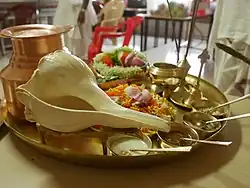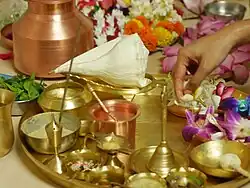Puja thali
A puja thali (Sanskrit: पूजा थाली, romanized: Pūjā thālī, lit. 'prayer plate') is a tray or large container on which puja materials are accumulated and decorated.[1] On Hindu religious occasions, festivals, traditions and rituals, the puja thali maintains an auspicious role. A puja thali may be made of steel, gold, silver, brass, or any other metal; it may be rounded, oval, or any other shaped or with little engravings and other decorations.


_Aarti_Thali%252C_Prayer_Plate_India.jpg.webp)
Materials
The following materials must be in a puja thali :
- Turmeric paste/sindura (Vermilion) paste/Rangoli color for holy symbols like 'Om', 'Swastika' etc.
- Akshata (unbroken rice grains).
- Diyas and incense sticks (Agarwood).
- Coconuts
- Flowers (marigolds, roses, and various designs with single color petals or a combination of different colors).
- Prasadam.
- Holy water in a container.
Along with these, a ghanta (bell), a conch (Shankha), a kalasha (holy pitcher) with holy water, ghee, camphor, betel-leaves, tulasi, milk, fresh fruits, sandalwood-paste, kumkuma, murti (earthen images) of deities and gold or silver coins may be include as needed.[1]
Variations
On the occasion of Deepavali, more than one diya might be arranged on thali; on Raksha Bandhan, a rakhi may be added. Bael-leaves and datura flowers are included in the thali for the Mahashivaratri festival.[2][3]

References
- "Diwali Puja thali" (HTML). festivals.iloveindia.com. 1 August 2007.
- "Har Har Mahadev" (HTML). Dainik bhaskar.com. 24 August 2007.
- "New wife Welcome". Jagran.com. 1 August 2007. Archived from the original (HTML) on 28 September 2007. Retrieved 16 June 2016.